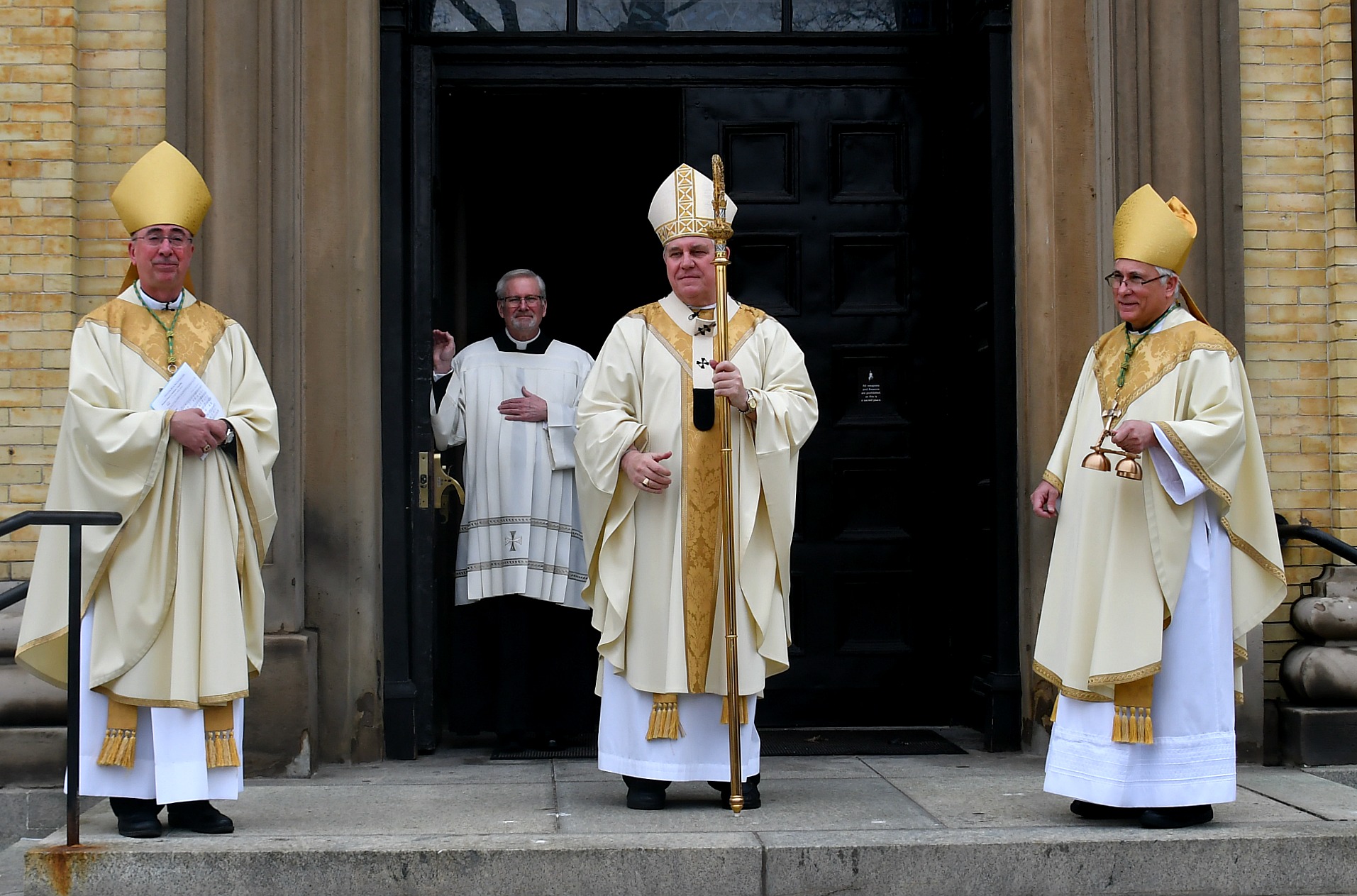
Archbishop Jerome E. Listecki with Bishop James T. Schuerman (left) and Bishop Jeffrey R. Haines (right) on Easter 2020 at the Cathedral of St. John the Evangelist. (Photo by David Bernacchi)
While the differences between Bishops Jeffrey R. Haines and James T. Schuerman allow them to complement each other in their roles as auxiliary bishops for the Archdiocese of Milwaukee, it’s the traits they share that have allowed them to thrive in those roles since they were ordained in 2017.
“They complement one another, but there’s a few things they (both) do very well,” Archbishop Jerome E. Listecki said. “Both of them have the heart of a priest, which is very important. They’ve both proven to be very capable administrators. They’ve both had successful times in the parish where they’ve helped to build the community. Even though they may be different in terms of personality, they link together in having a priestly heart. They have a mind for the Church. They’ve been very supportive of the programs the archdiocese has implemented.”
As the Bishop of La Crosse, Archbishop Listecki didn’t have auxiliary bishops, but he was one of six auxiliary bishops during his time in Chicago.
“I know well what’s expected of the role,” he said.
When Archbishop Listecki first arrived in Milwaukee, Bishop Richard J. Sklba was the auxiliary bishop. When Sklba retired, Bishop Donald J. Hying (now the bishop of Madison) was consecrated as auxiliary bishop in 2011. Hying stayed in that role until 2014, when he was named the bishop of Gary, Indiana.
So, when Bishops Haines and Schuerman were selected in January 2017 as auxiliary bishops, it filled a hole in the archdiocese. At the time, Archbishop Listecki had asked the Vatican if he could have two auxiliary bishops.
“You never know in terms of the response of the Church to any kind of request,” Archbishop Listecki said. “Although it’s sort of like a parish who has needs, the Church has multiple needs. You don’t know to what extent they’re going to fulfill your requests.”
Following their consecration as bishops March 17, 2017, Archbishop Listecki said the two auxiliary bishops spent at least a year just learning what came with their new positions in the Church.
“They’re the hidden gems of the archdiocese,” Archbishop Listecki said. “I say that because as they get known more and more among other bishops in the conference, they become susceptible to being chosen because of their abilities (to be named bishop of their own diocese). I’d be happy for them — I’d be happy for the Church — but I’d be sorry for myself as well as the archdiocese in losing either of these individuals.”
When a diocese or archdiocese is looking for new bishops, the input of fellow members of the clergy is solicited. Archbishop Listecki said both of the auxiliary bishops were named by a good portion of their fellow priests.
“I knew the quality of each man,” Archbishop Listecki said. “I already knew their priestly character, their pastoral ability and their commitment to the Church. That was affirmed by the fact they were so respected by the clergy. Having worked with both of them as pastors, and Bishop Haines in particular as the past president of the priest council, I knew these were men who shared a commitment and a vision to the Church.”
Bishop Schuerman said one of the things that was pleasantly surprising, and very gratifying, to him when he first became a bishop came at his first meeting of the Wisconsin Catholic Conference. He was impressed with how seamlessly and graciously they were welcomed to the ranks of bishops in the state.
Part of that acceptance and fraternity comes from knowing the selection is made by the Church with a nudge from the Holy Spirit.
“I would add something else – those guys are all Wisconsinites,” Archbishop Listecki said. “As a result, they’re already sharing a sense of the love for the Catholic Church and, in particular, the love for the Church in the state of Wisconsin. The other bishops who were there were recognizing their ability. If you look at the bishops who were there, they were all great pastors, they knew what it is to extend themselves and there is also a recognition that when you’re selected, you are a part of the episcopacy. When you’re part of the episcopacy, there’s an acceptance, whether you’ve been a bishop for one day or 30 years.”
Archbishop Listecki said the fraternity among bishops extends all the way up to the pope, noting that when he has met with St. John Paul II, Pope Benedict or Pope Francis, he has always been treated as a fellow bishop.
“That kind of strikes you to understand the office that you carry and the ordination that’s been given to you by the Church,” Archbishop Listecki said.
In their five years as bishops, Haines and Schuerman have shown themselves to be men who love the Church and the priesthood, and have garnered respect for their ability to work with staff and the various offices in the archdiocese.
“We are very fortunate to have these two individuals and to have been able to use their work and their efforts to help build the Archdiocese of Milwaukee,” Archbishop Listecki said. “As I look to my retirement, I do so with great confidence that these are individuals who will make sure the Church will continue in its growth. Hopefully, it continues to grow as God wants it to – in holiness.”
